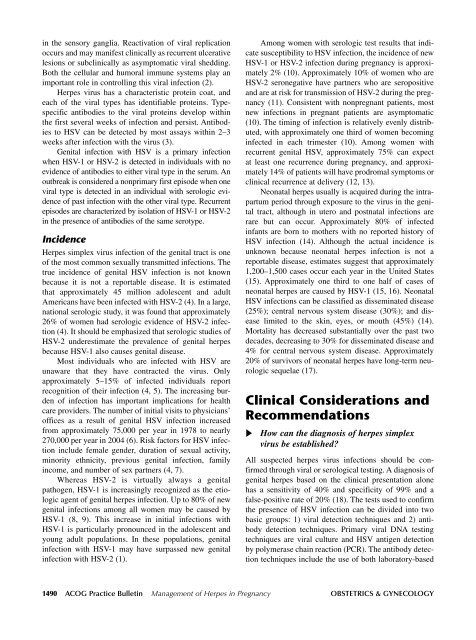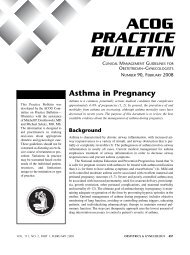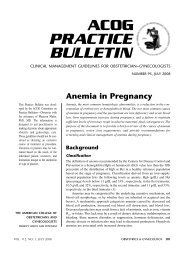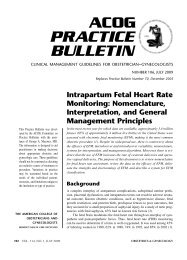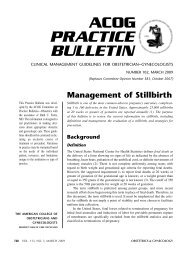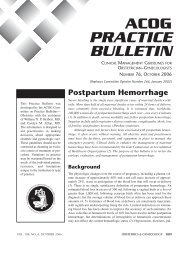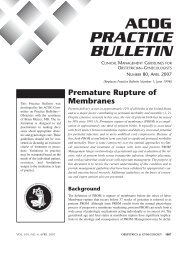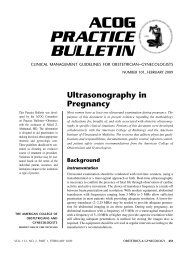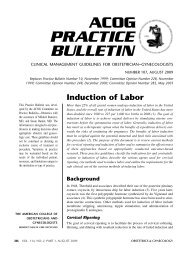ACOG Practice Bulletin No. 82: Management of Herpes in Pregnancy
ACOG Practice Bulletin No. 82: Management of Herpes in Pregnancy
ACOG Practice Bulletin No. 82: Management of Herpes in Pregnancy
Create successful ePaper yourself
Turn your PDF publications into a flip-book with our unique Google optimized e-Paper software.
<strong>in</strong> the sensory ganglia. Reactivation <strong>of</strong> viral replication<br />
occurs and may manifest cl<strong>in</strong>ically as recurrent ulcerative<br />
lesions or subcl<strong>in</strong>ically as asymptomatic viral shedd<strong>in</strong>g.<br />
Both the cellular and humoral immune systems play an<br />
important role <strong>in</strong> controll<strong>in</strong>g this viral <strong>in</strong>fection (2).<br />
<strong>Herpes</strong> virus has a characteristic prote<strong>in</strong> coat, and<br />
each <strong>of</strong> the viral types has identifiable prote<strong>in</strong>s. Typespecific<br />
antibodies to the viral prote<strong>in</strong>s develop with<strong>in</strong><br />
the first several weeks <strong>of</strong> <strong>in</strong>fection and persist. Antibodies<br />
to HSV can be detected by most assays with<strong>in</strong> 2–3<br />
weeks after <strong>in</strong>fection with the virus (3).<br />
Genital <strong>in</strong>fection with HSV is a primary <strong>in</strong>fection<br />
when HSV-1 or HSV-2 is detected <strong>in</strong> <strong>in</strong>dividuals with no<br />
evidence <strong>of</strong> antibodies to either viral type <strong>in</strong> the serum. An<br />
outbreak is considered a nonprimary first episode when one<br />
viral type is detected <strong>in</strong> an <strong>in</strong>dividual with serologic evidence<br />
<strong>of</strong> past <strong>in</strong>fection with the other viral type. Recurrent<br />
episodes are characterized by isolation <strong>of</strong> HSV-1 or HSV-2<br />
<strong>in</strong> the presence <strong>of</strong> antibodies <strong>of</strong> the same serotype.<br />
Incidence<br />
<strong>Herpes</strong> simplex virus <strong>in</strong>fection <strong>of</strong> the genital tract is one<br />
<strong>of</strong> the most common sexually transmitted <strong>in</strong>fections. The<br />
true <strong>in</strong>cidence <strong>of</strong> genital HSV <strong>in</strong>fection is not known<br />
because it is not a reportable disease. It is estimated<br />
that approximately 45 million adolescent and adult<br />
Americans have been <strong>in</strong>fected with HSV-2 (4). In a large,<br />
national serologic study, it was found that approximately<br />
26% <strong>of</strong> women had serologic evidence <strong>of</strong> HSV-2 <strong>in</strong>fection<br />
(4). It should be emphasized that serologic studies <strong>of</strong><br />
HSV-2 underestimate the prevalence <strong>of</strong> genital herpes<br />
because HSV-1 also causes genital disease.<br />
Most <strong>in</strong>dividuals who are <strong>in</strong>fected with HSV are<br />
unaware that they have contracted the virus. Only<br />
approximately 5–15% <strong>of</strong> <strong>in</strong>fected <strong>in</strong>dividuals report<br />
recognition <strong>of</strong> their <strong>in</strong>fection (4, 5). The <strong>in</strong>creas<strong>in</strong>g burden<br />
<strong>of</strong> <strong>in</strong>fection has important implications for health<br />
care providers. The number <strong>of</strong> <strong>in</strong>itial visits to physicians’<br />
<strong>of</strong>fices as a result <strong>of</strong> genital HSV <strong>in</strong>fection <strong>in</strong>creased<br />
from approximately 75,000 per year <strong>in</strong> 1978 to nearly<br />
270,000 per year <strong>in</strong> 2004 (6). Risk factors for HSV <strong>in</strong>fection<br />
<strong>in</strong>clude female gender, duration <strong>of</strong> sexual activity,<br />
m<strong>in</strong>ority ethnicity, previous genital <strong>in</strong>fection, family<br />
<strong>in</strong>come, and number <strong>of</strong> sex partners (4, 7).<br />
Whereas HSV-2 is virtually always a genital<br />
pathogen, HSV-1 is <strong>in</strong>creas<strong>in</strong>gly recognized as the etiologic<br />
agent <strong>of</strong> genital herpes <strong>in</strong>fection. Up to 80% <strong>of</strong> new<br />
genital <strong>in</strong>fections among all women may be caused by<br />
HSV-1 (8, 9). This <strong>in</strong>crease <strong>in</strong> <strong>in</strong>itial <strong>in</strong>fections with<br />
HSV-1 is particularly pronounced <strong>in</strong> the adolescent and<br />
young adult populations. In these populations, genital<br />
<strong>in</strong>fection with HSV-1 may have surpassed new genital<br />
<strong>in</strong>fection with HSV-2 (1).<br />
Among women with serologic test results that <strong>in</strong>dicate<br />
susceptibility to HSV <strong>in</strong>fection, the <strong>in</strong>cidence <strong>of</strong> new<br />
HSV-1 or HSV-2 <strong>in</strong>fection dur<strong>in</strong>g pregnancy is approximately<br />
2% (10). Approximately 10% <strong>of</strong> women who are<br />
HSV-2 seronegative have partners who are seropositive<br />
and are at risk for transmission <strong>of</strong> HSV-2 dur<strong>in</strong>g the pregnancy<br />
(11). Consistent with nonpregnant patients, most<br />
new <strong>in</strong>fections <strong>in</strong> pregnant patients are asymptomatic<br />
(10). The tim<strong>in</strong>g <strong>of</strong> <strong>in</strong>fection is relatively evenly distributed,<br />
with approximately one third <strong>of</strong> women becom<strong>in</strong>g<br />
<strong>in</strong>fected <strong>in</strong> each trimester (10). Among women with<br />
recurrent genital HSV, approximately 75% can expect<br />
at least one recurrence dur<strong>in</strong>g pregnancy, and approximately<br />
14% <strong>of</strong> patients will have prodromal symptoms or<br />
cl<strong>in</strong>ical recurrence at delivery (12, 13).<br />
Neonatal herpes usually is acquired dur<strong>in</strong>g the <strong>in</strong>trapartum<br />
period through exposure to the virus <strong>in</strong> the genital<br />
tract, although <strong>in</strong> utero and postnatal <strong>in</strong>fections are<br />
rare but can occur. Approximately 80% <strong>of</strong> <strong>in</strong>fected<br />
<strong>in</strong>fants are born to mothers with no reported history <strong>of</strong><br />
HSV <strong>in</strong>fection (14). Although the actual <strong>in</strong>cidence is<br />
unknown because neonatal herpes <strong>in</strong>fection is not a<br />
reportable disease, estimates suggest that approximately<br />
1,200–1,500 cases occur each year <strong>in</strong> the United States<br />
(15). Approximately one third to one half <strong>of</strong> cases <strong>of</strong><br />
neonatal herpes are caused by HSV-1 (15, 16). Neonatal<br />
HSV <strong>in</strong>fections can be classified as dissem<strong>in</strong>ated disease<br />
(25%); central nervous system disease (30%); and disease<br />
limited to the sk<strong>in</strong>, eyes, or mouth (45%) (14).<br />
Mortality has decreased substantially over the past two<br />
decades, decreas<strong>in</strong>g to 30% for dissem<strong>in</strong>ated disease and<br />
4% for central nervous system disease. Approximately<br />
20% <strong>of</strong> survivors <strong>of</strong> neonatal herpes have long-term neurologic<br />
sequelae (17).<br />
Cl<strong>in</strong>ical Considerations and<br />
Recommendations<br />
How can the diagnosis <strong>of</strong> herpes simplex<br />
virus be established<br />
All suspected herpes virus <strong>in</strong>fections should be confirmed<br />
through viral or serological test<strong>in</strong>g. A diagnosis <strong>of</strong><br />
genital herpes based on the cl<strong>in</strong>ical presentation alone<br />
has a sensitivity <strong>of</strong> 40% and specificity <strong>of</strong> 99% and a<br />
false-positive rate <strong>of</strong> 20% (18). The tests used to confirm<br />
the presence <strong>of</strong> HSV <strong>in</strong>fection can be divided <strong>in</strong>to two<br />
basic groups: 1) viral detection techniques and 2) antibody<br />
detection techniques. Primary viral DNA test<strong>in</strong>g<br />
techniques are viral culture and HSV antigen detection<br />
by polymerase cha<strong>in</strong> reaction (PCR). The antibody detection<br />
techniques <strong>in</strong>clude the use <strong>of</strong> both laboratory-based<br />
1490 <strong>ACOG</strong> <strong>Practice</strong> <strong>Bullet<strong>in</strong></strong> <strong>Management</strong> <strong>of</strong> <strong>Herpes</strong> <strong>in</strong> <strong>Pregnancy</strong> OBSTETRICS & GYNECOLOGY


